The International Council on Museums and Sites (ICOMOS) has named the theme of this year’s International Day for Monuments and Sites as:
Shared Cultures, Shared Heritage, Shared Responsibility.
Shared heritage brings to mind the many stories that make up a place – the different memories, perspectives, and experiences that are woven into the history of each monument and site.
Through much of the modern era, the narrative of a site often did not include all perspectives. This is especially prevalent in sites where the perspective of a dominant culture overshadowed that of indigenous or other marginalised people. Today, there is a distinct focus across the heritage field in giving voice to these stories, expanding how these perspectives can be more widely shared.
Looking to Diverse Cultural Expressions
We can look beyond the monument or site, to the stories, photographs, music, poetry and archival records made by people who have lived there. People who interacted with the same influences that brought about the site, but who could also show us different facets of its cultural heritage.
Beyond this, exploring documentary heritage together with its contemporary, or otherwise related, monuments and sites can enrich our understanding of the cultures from which they come. It can deepen our appreciation and experience of these cultures, by putting the monument or site into a very human context.
Come along as we explore a few examples of documentary heritage from the UNESCO Memory of the World Register, together with UNESCO World Heritage sites, and see how they enrich one another.
_____________________________________________________
Document
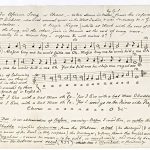
Photo: Gloucestershire Archives, Song of Slaves in Barbados via UNESCO link
An African Song or Chant from Barbados
The text of this song or chant is the only known of its kind depicting a work song, sung by African slaves in the sugar fields of Barbados. It gives voice to a voiceless community in a very literal way. The lyrics depict life from the perspective of the enslaved, their experiences and their suffering. It also tells of their survival, as song was a tool for resilience.
Site
Historic Bridgetown and its Garrison (Barbados)
This site was included on the World Heritage list as an outstanding example of British
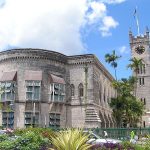
Photo: Parliament building, Historic Bridgetown, public domain, link
colonial architecture during the 17th-19th centuries. It is a testament to Great Britain’s influence and spread of its empire with colonies in the Atlantic.
The port town was an important trade point for goods including sugar, as well as the import of enslaved Africans heading to Barbados and the rest of the Americas.
The colonial architecture of historic Bridgetown and its Garrison reflect both the British architectural style and the military command and control of the region – very much the dominant culture at the time. When looked at together with the testament of a life of enslavement, offered through the African work song, it is possible to get a far more complete picture of the human cost of colonial expansion – cities built through trade, but at a great expense to humanity.
_____________________________________________________
Document
Archive of Warsaw Reconstruction Office
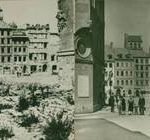
Photo: from The State Archives of the Capital City of Warsaw, via UNESCO, link
Following the destruction of Warsaw during the Second World War, the rebuilding of the capital became deeply symbolic for the Polish people.
Over the years 1945-1953, the outstanding achievement of reconstruction was an effort of architects, artists, craftsmen, conservators and construction workers. These archives give testament of the massive undertaking that was the city’s rebuilding.
Site
Historic Centre of Warsaw (Poland)
The careful restoration of the Old Town of Warsaw, featuring architecture spanning the 13th to the 20th century, is

Photo: Warsaw Old Town Market Square , Maksym Kozlenko / CC BY-SA, link
an outstanding example of a near-total reconstruction.
Without knowledge of the story of its reconstruction, the historic centre of Warsaw might appear to be no more remarkable than any other central European city. However, the process of rebuilding after the attempted destruction by the Nazi occupation for ideological and political reasons is of great social significance. Knowing the story of this “invincible city”, deeply seeped in social identity, gives a new meaning to the practice of monument preservation.
_____________________________________________________
Document
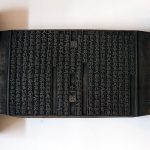
Korean wood printing block from the 19th century, CC0 link
This collection of 64,226 hand-carved woodblocks would be used to produce printed documents during the Korean
Joseon Dynasty (1392–1910). The titles of work printed from these blocks covered a range of subjects, such as literature, politics, economy, philosophy, and interpersonal relations.
These blocks represent a means to exchange ideas, especially those relating to Confucian ideals. The goal of this dissemination of ideas would be to create communities deeply rooted in Confucian morality.
Site
Historic Villages of Korea: Hahoe and Yangdong (Republic of Korea)
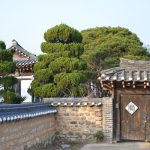
Photo: House in Hahoe Village, Clsd1 / CC BY-SA link
The historic villages of Hahoe and Yangdong are excellent examples of typical clan villages in the Republic of Korea during the Joseon Dynasty (1392-1910). They are representative of a distinct, privileged Confucian culture, reflected in their layout and location among forested mountains, rivers and open fields.
In fact, these villages might be considered the physical embodiment of the ideal community built on Confucian morality, described in documents printed with hand-carved woodblocks.
Considering these historical villages in context with the exchange of information between scholars and intellectuals across centuries, which these woodblocks testify to, allows for a more complete picture of values and ideas during the Joseon Dynasty.
_____________________________________________________
Document
Criminal Court Case No. 253/1963 (State Versus N Mandela and Others)

Travel diary from the Rivonia Trial (State v. Nelson Mandela and Others), Nelson Mandela / CC0 link
The Rivonia Trial in 1960 saw the state of South Africa arrest and prosecute leadership of the African National
Congress (ANC), one of the country’s largest anti-apartheid organisations. During the subsequent trial, Nelson Mandela proclaimed the ANC’s goal of a democratic South Africa from the courthouse to the public. This trial led to his, and others, imprisonment, which would last until apartheid was finally rejected in the early 1990’s.
Site
Robben Island (South Africa)
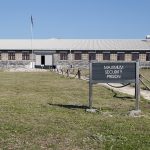
Photo: Robben Island, by Moheen Reeyad, via Wikimedia, CC BY-SA 4.0, link
Though this site had many uses since its construction in the 17th century, it is its function as a maximum-security prison for political prisoners which is most infamous.
The story of the detention, and eventual liberation, of Nelson Mandela and other anti-apartheid activists at Robben Island is a testament to the triumph of freedom over oppression. Seeing the place where these prisoners were kept following the trail, detailed in the court records, helps to bring the era of apartheid and struggle for democracy to life.
_____________________________________________________
Document
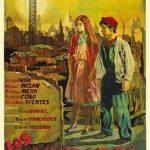
Photo: poster for Los Olvidados, via Wikimeida, Fair use, link
This film by Spanish-Mexican director Luis Buñuel was released in 1950, and is considered among the most
important documents in Spanish language depicting the lives of children living in the margins of 20th-century cities.
Released in the United States as “The Young and the Damned”, Los olvidados focusses on Mexico City, giving a realist, unyielding account of the city’s slums, in which characters live their lives at the mercy of their socioeconomic circumstances.
Site
Historic Centre of Mexico City and Xochimilco (Mexico)
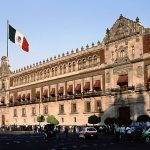
Photo: National Palace in Mexico City, CC BY-SA 2.0 link
Mexico City, built by the Spanish on the ruins of the old Aztec capital Tenochtitlan, has been important to the region for centuries. It is now one of the world’s largest cities, both geographically and in population density.
Known in colonial New Spain as the “city of palaces”, the largest Latin American Cathedral and fine 19th- and 20th-century public buildings combine with indigenous and purely Mexican elements to give this city its unique identity.
Considering Buñuel’s film together with the World Heritage Site of Mexico City’s historic centre creates a picture of different realities – and sides – to this city. It is a reminder that there are many centuries of stories, overlapping and interweaving with one another, that live in a single place.
_____________________________________________________
Document

Treaty of Waitangi / Public domain, link
This document is of great national importance to New Zealand, as The Treaty of Waitangi is the founding document
of the nation. It was signed in February 1840 by Captain William Hobson, several English residents and approximately 45 Maori chiefs.
Site
Tongariro National Park (New Zealand)
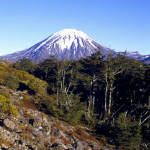
Photo: Tongariro National Park, Peter Lockhart via Wikimedia / CC By 2.5 link
Tongariro National Park is an excellent example of a Cultural Landscape, a site where the natural landscape and the
culture of the people living there are indelibly intertwined. The heart of the park is home to mountains that are of cultural and religious significance to the Maori people. The landscape throughout this region symbolises the deep spiritual links between the indigenous community and their environment.
The history of New Zealand isn’t complete without including the relationship between the Maori people and the land, and the examination of these two sides to the country’s identity together strengthens one’s sense of place.
_____________________________________________________
Document
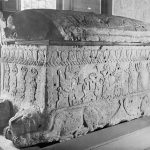
Photo: the Sarcophagus of Ahiram, via Wikimedia, CC0 link
Photo: the Sarcophagus of Ahiram, via Wikimedia, CC0 linkThe Phoenician Alphabet was the prototype for all alphabets that came later. This system of writing was adapted
throughout the ancient world and would be used to exchange ideas and knowledge in humanities, religious study, science, and culture.
The development of the Phoenician Alphabet is recorded across a collection of engravings on stone, metal and other materials, from the sarcophagus of Ahiram, King of Byblos (thirteenth century BCE) to items from the Roman era in the first century CE.
Site
Byblos (Lebanon)
The city of Byblos has been inhabited since Neolithic times, but is perhaps most remarkable for its testament to the
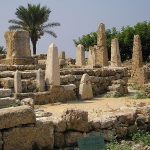
Photo: Byblos Obelisk Temple,: Heretiq via Wikimedia, CC BY-SA 2.5 link
beginning of the Phoenician civilization. The architecture of this site bears witness to its long history as a crossroads of civilizations, with examples ranging from Bronze age monuments to Persian fortifications, Roman roads, Byzantine churches, the Crusade citadel and the Medieval and Ottoman towns.
Byblos was also central to the development and spread of the Phoenician Alphabet, the origin of the contemporary Latin alphabet.
Considering the enormous importance of the Phoenician Alphabet on written word, and the way we communicate today, the record of its development enriches understanding of sites like Byblos, making ancient influence still feel relevant.